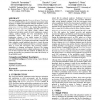182 search results - page 28 / 37 » Morphing methods in evolutionary design optimization |
107
Voted
ICML
1998
IEEE
16 years 1 months ago
1998
IEEE
This paper introduces a new algorithm, Q2, foroptimizingthe expected output ofamultiinput noisy continuous function. Q2 is designed to need only a few experiments, it avoids stron...
103
Voted
GECCO
2008
Springer
15 years 1 months ago
2008
Springer
In this work an improvement of an initial approach to design Artificial Neural Networks to forecast Time Series is tackled, and the automatic process to design Artificial Neural N...
132
click to vote
GECCO
2010
Springer
15 years 5 months ago
2010
Springer
Evolutionary methods have been used to repair programs automatically, with promising results. However, the fitness function used to achieve these results was based on a few simpl...
108
click to vote
GECCO
2008
Springer
15 years 1 months ago
2008
Springer
This paper investigates how the Univariate Marginal Distribution Algorithm (UMDA) behaves in non-stationary environments when engaging in sampling and selection strategies designe...
93
Voted
GECCO
2009
Springer
15 years 7 months ago
2009
Springer
This work provides an analysis of using the evolutionary algorithm EPNet to create ensembles of artificial neural networks to solve a range of forecasting tasks. Several previous...

